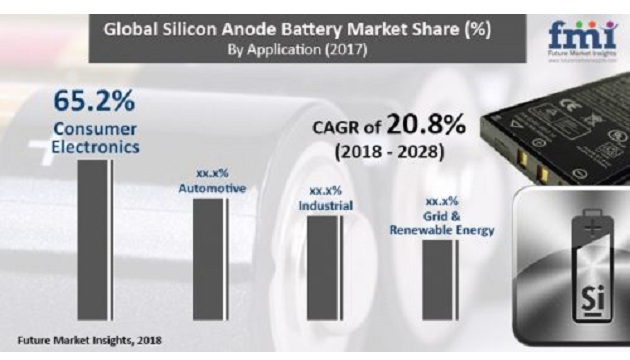Silicon anode battery market is professed to be in its preliminary stages of growth as paralleled to other conventional batteries. The replacement of graphite anode with silicon is anticipated to be one of the biggest trends in the global battery market. According to the report, the market is expected to witness a Herculean CAGR of 20.8% from 2018 to 2028. The market was worth US$ 126.4 Mn in 2017 and is projected to touch a valuation of US$ 982.6 Mn by the end of 2028.
The burgeoning production of smart consumer electronics along with devices such as motion sensors, and GPS, among others has led to a rise in the demand for efficient battery solution that can maintain decent battery life while running high power consuming applications. The rapidly growing shipment of electronic devices, and appliances will be the key driving factor for the global silicon anode battery market. Substantial growth in the service and manufacturing sectors has led to a healthy growth in GDP worldwide. This, in turn, has had a positive impact on the global spending on smartphones, thereby eventually impacting the demand for silicon anode battery.
As a result of the above, companies operating in the market are focusing on product development, plant expansion, and mergers and acquisitions. For instance, in October 2016, LG Chem inaugurated an automotive battery manufacturing plant in Poland to expand and strengthen its market presence. Other companies operating in the market are XG Sciences, Nexeon Limited, Enevate Corporation, Nanotek Instruments, Inc., Panasonic Corporation, Zeptor Corporation, and Amprius, Inc., among others.
Electronic Miniaturization to Trigger Market Progress
Silicon anode batteries are expansively employed currently as a power source in portable consumer electronics and automotive, such as 3G cell phones, tablets, laptops, MP4 players, and digital cameras, hybrid electric vehicles and electric bicycles due to their high voltage, long life span, and high energy density. With reference to miniaturization, development of micro-batteries or thin-film batteries for implantable restorative devices and MEMS (micro electro mechanical systems) is expected to propel the market for silicon anode batteries.
This nanotechnology and micro electromechanical systems (MEMS) are increasing in functionality as well as approval in a bulk of applications among various industries, such as consumer electronics, aerospace, automotive, and medical devices and others. The present pace of miniaturization of electronic devices will result in a surge in demand for silicon anode batteries in near future. Similarly, miniaturization of electronic devices, such as laptops, smartphones, consumer electronics, etc. has led to an augmented usage of silicon as an anode in lithium-ion batteries.
Nascent Adoption to Pose Limitation to Market Growth
The lithium-ion battery market has taken off over the last ten years. This gush in demand was mainly owing to its uptake in smartphones. Despite the fact that lithium-ion chemistry was invented back in 1970s, its first commercialization was done in the early 1990s. Nevertheless, it is assessed that the introduction of novel products in the niche battery sector will take comparatively a longer time span to commercialize. It is thereby anticipated to follow the same inclination as the lithium-ion batteries market, which is expected to encounter the growth of the silicon anode battery market in the near future.
Click here for more information








